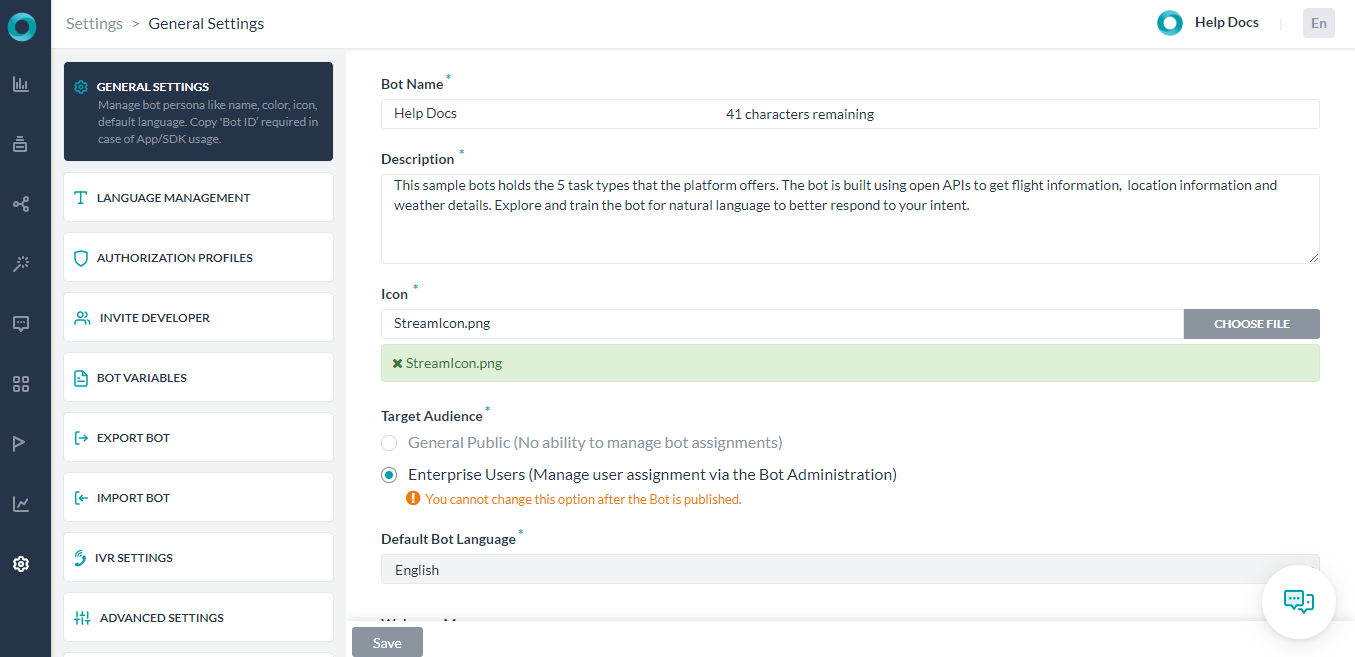봇 빌더를 사용하여 봇을 생성한 후 봇 아이콘 또는 설명을 업데이트하거나 추가하려면 고급 설정과 선택 설정을 변경하거나 정의해야 할 수 있습니다. 이 항목에서는 기존 봇을 편집하는 방법을 설명합니다.
봇 설정 수정하기
봇의 설정 페이지를 열려면 다음 단계를 따르세요.
설정 페이지에는 표준 봇 또는 범용 봇에 따라 다음과 같은 섹션이 있습니다.
- 일반 설정: 봇 이름, 설명, 아이콘, 색상 등을 정의하거나 수정합니다. 자세한 내용은 일반 봇 설정을 참조하세요.
- 언어 관리: 봇 언어 및 언어 감지 기능을 관리합니다. 자세한 내용은 추가 봇 언어 사용하기를 참조하세요.
- PII 설정: Kore.ai는 사용자가 봇과 공유하는 모든 민감한 정보 유형을 삭제할 수 있습니다. 정보 유형의 삭제를 사용하도록 설정하면, 해당 값을 이해할 수 있는 데이터가 포함되지 않은 패턴으로 변환할 수 있습니다. 개인 식별 정보 삭제하기를 참조하세요
- 봇 기능: 사용자 정의 스크립트를 사용하면 다른 작업, 노드, 기타 봇 요소가 사용할 수 있는 재사용 가능 유틸리티 JavaScript 기능을 수집하고 관리할 수 있습니다. 봇 기능을 참조하세요.
- 봇 변수: 작업 및 설정을 정의할 때 사용 가능한 변수를 추가합니다. 이러한 변수는 봇 간에 봇 정의를 가져올 때 매우 유용합니다. 자세한 내용은 봇 변수 사용하기를 참조하세요.
- 인증 프로필: 봇이 타사 웹 서비스에 액세스할 수 있도록 기본 인증, oAuth v1, oAuth v2, 또는 API 키로 하나 이상의 인증 프로파일을 정의합니다. 자세한 내용은 봇 권한 부여를 참조하세요.
- 개발자 관리: 기업에서는 공동 개발을 위해 봇을 다른 개발자에게 공유할 수 있습니다. 자세한 내용은 개발을 위한 봇 공유하기를 참조하세요.
- 봇 내보내기 및 가져오기: 봇 작업과 설정을 다른 봇으로 가져올 수 있는 JSON 파일로 내보냅니다. 또는 유효한 JSON 파일을 가져와서 봇 작업과 설정을 덮어씁니다. 자세한 내용은 봇 내보내기 및 가져오기를 참조하세요.
- 변경 로그: 사용자, 이벤트, 타임 스탬프별로 봇과 관련된 시스템 이벤트 목록을 봅니다. 자세한 내용은 봇 변경 로그 보기를 참조하세요.
- 봇 삭제: 봇을 삭제하려면 클릭합니다. 게시되지 않은 봇과 일시 중단된 봇만 삭제할 수 있습니다. 봇에 게시된 작업이 있으면 삭제할 수 없습니다. 자세한 내용은 봇 삭제하기를 참조하세요.

